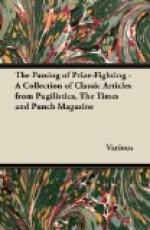No. 102. Miniature of a Lady Unknown. It is impossible at this lapse of time to identify the original of this portrait. No doubt she belonged to a short-lived and somewhat degraded class known as “professional beauties.” In one hand she holds an instrument called an opera-glass, which was used in the last century at trials for murder at the Old Bailey. The hair she wears on her head is evidently false, and has been supplied from some foreign peasantry. Her hat is adorned with a stuffed bird, suggestive of the cruelty of her nature. As she holds in her other hand a book labelled, “The Art of Nursing,” it may be conjectured that she is a frequent visitor to the Dissecting-Room, or the Accident Ward of a London Hospital. On the whole, perhaps, it is fortunate that her name has not been preserved by succeeding generations. She must, indeed, have been a contrast to her angelic descendants of the present day.
No. 2478. An Utensil Made of Brass. This strange-looking object may have been used by our ancestors as a helmet, or perhaps as a fish-kettle. It is, perhaps, rather large for the first, and a little too thick for the second. The Catalogue describes the exhibit as “a coal-scuttle.” It is impossible to verify this assertion, as coal is now only found in specimen cases at museums, and a sketch of a coal-scuttle has not been seen for the last fifty years. It is, however, interesting as suggestive of a time when the world was not heated by volcanic hot water.
* * * * *
[Illustration: Seasonable “on this Head.”]
SEASONABLE REPLY (By Our Own Politest Letter-Writer.)—This is a model for a cautious answer at this time of year to an invitation to witness an out-of-door ceremony, the laying of a first stone, &c, &c, returning to London same day:—“Dear A——, if I am (1) alive, (2) well, (3) with no urgent business, (4) in London, and if the weather is (i.) fine, (ii.) fairly warm, (iii.) likely to last so, (iv.) wind S.W., (v.) no remains of sloshy thaw, (vi.) no frost; if there are comfortable conveyances to and from station; if there is a perfectly dry spot for me to stand on, and see and hear everything, and no draughts, and if there is a good lunch in a comfortable, dry, well-aired, and warmed room, with not too many guests, and plenty of good waiters, also with dry champagne,—say Pommery ’80 or ’84, for choice,—then you may expect me, and I accept, with the greatest possible pleasure.
Yours ever, D. DASH.”




